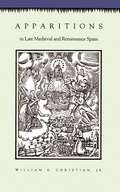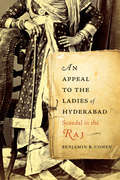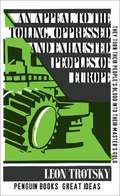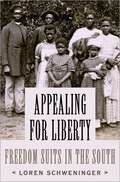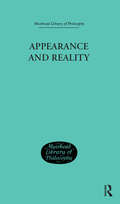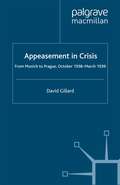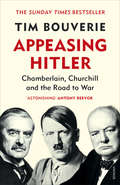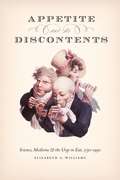- Table View
- List View
Apparitions in Late Medieval and Renaissance Spain (PDF)
by William A. Christian Jr.The description for this book, Apparitions in Late Medieval and Renaissance Spain, will be forthcoming.
An Appeal to the Ladies of Hyderabad: Scandal in the Raj
by Benjamin B. CohenBenjamin Cohen tells the dramatic story of Mehdi Hasan and Ellen Donnelly, whose marriage convulsed high society in nineteenth-century India and whose notorious trial reverberated throughout the British Empire, setting the benchmark for Victorian scandals. In the struggle of one couple, he exposes the fault lines that would soon tear a world apart.
An Appeal to the Toiling, Oppressed and Exhausted Peoples of Europe (Penguin Great Ideas Ser.)
by Leon TrotskyWhether calling for an end to the capitalist system, addressing the crowds after the Russian Revolution, or attacking Stalin during his years of exile, Trotsky’s speeches give an extraordinary insight into a man whose words and actions determined the fates of millions. Throughout history, some books have changed the world. They have transformed the way we see ourselves – and each other. They have inspired debate, dissent, war and revolution. They have enlightened, outraged, provoked and comforted. They have enriched lives – and destroyed them. Now Penguin brings you the works of the great thinkers, pioneers, radicals and visionaries whose ideas shook civilization and helped make us who we are.
Appealing for Liberty: Freedom Suits in the South
by Loren SchweningerDred Scott and his landmark Supreme Court case are ingrained in the national memory, but he was just one of multitudes who appealed for their freedom in courtrooms across the country. Appealing for Liberty is the most comprehensive study to give voice to these African Americans, drawing from more than 2,000 suits and from the testimony of more than 4,000 plaintiffs from the Revolutionary era to the Civil War. Through the petitions, evidence, and testimony introduced in these court proceedings, the lives of the enslaved come sharply and poignantly into focus, as do many other aspects of southern society such as the efforts to preserve and re-unite black families. This book depicts in graphic terms, the pain, suffering, fears, and trepidations of the plaintiffs while discussing the legal systemlawyers, judges, juries, and testimonythat made judgments on their "causes," as the suits were often called. Arguments for freedom were diverse: slaves brought suits claiming they had been freed in wills and deeds, were born of free mothers, were descendants of free white women or Indian women; they charged that they were illegally imported to some states or were residents of the free states and territories. Those who testified on their behalf, usually against leaders of their communities, were generally white. So too were the lawyers who took these cases, many of them men of prominence, such as Francis Scott Key. More often than not, these men were slave owners themselves-- complicating our understanding of race relations in the antebellum period. A majority of the cases examined here were not appealed, nor did they create important judicial precedent. Indeed, most of the cases ended at the county, circuit, or district court level of various southern states. Yet the narratives of both those who gained their freedom and those who failed to do so, and the issues their suits raised, shed a bold and timely light on the history of race and liberty in the "land of the free."
Appealing for Liberty: Freedom Suits in the South
by Loren SchweningerDred Scott and his landmark Supreme Court case are ingrained in the national memory, but he was just one of multitudes who appealed for their freedom in courtrooms across the country. Appealing for Liberty is the most comprehensive study to give voice to these African Americans, drawing from more than 2,000 suits and from the testimony of more than 4,000 plaintiffs from the Revolutionary era to the Civil War. Through the petitions, evidence, and testimony introduced in these court proceedings, the lives of the enslaved come sharply and poignantly into focus, as do many other aspects of southern society such as the efforts to preserve and re-unite black families. This book depicts in graphic terms, the pain, suffering, fears, and trepidations of the plaintiffs while discussing the legal systemlawyers, judges, juries, and testimonythat made judgments on their "causes," as the suits were often called. Arguments for freedom were diverse: slaves brought suits claiming they had been freed in wills and deeds, were born of free mothers, were descendants of free white women or Indian women; they charged that they were illegally imported to some states or were residents of the free states and territories. Those who testified on their behalf, usually against leaders of their communities, were generally white. So too were the lawyers who took these cases, many of them men of prominence, such as Francis Scott Key. More often than not, these men were slave owners themselves-- complicating our understanding of race relations in the antebellum period. A majority of the cases examined here were not appealed, nor did they create important judicial precedent. Indeed, most of the cases ended at the county, circuit, or district court level of various southern states. Yet the narratives of both those who gained their freedom and those who failed to do so, and the issues their suits raised, shed a bold and timely light on the history of race and liberty in the "land of the free."
Appearance and Identity Crisis in Modern Indian History: The Third Design (1857 A.D. – 2014 A.D.) (Routledge Studies in Modern History)
by Jeevan Jyoti ChakarawartiChakarawarti explores the history of Indian eunuchs from the Mughal empire’s fall following the mutiny of 1857 A.D. to the Supreme Court of India’s historic ruling in 2014 A.D.This book examines the social, political, economic, and religious aspects of Indian eunuchs’ lives, providing a true narrative of this marginalized group that has been neglected for centuries. It contains detailed stories of Indian eunuchs from the 1857 uprising to the historic decision to grant them the title of third gender in the Supreme Court of India in 2014. This includes the actual account of the court proceedings and how this decision brought about an enormous transition to their lives by granting them fundamental rights under the Constitution of India and the right to self-identification of their gender as male, female, or third gender.This book serves as an important resource for scholars of Gender Studies, Transgender Studies, and Subaltern History, and especially for those who are interested in Transgender Studies in modern Indian history.
Appearance and Identity Crisis in Modern Indian History: The Third Design (1857 A.D. – 2014 A.D.) (Routledge Studies in Modern History)
by Jeevan Jyoti ChakarawartiChakarawarti explores the history of Indian eunuchs from the Mughal empire’s fall following the mutiny of 1857 A.D. to the Supreme Court of India’s historic ruling in 2014 A.D.This book examines the social, political, economic, and religious aspects of Indian eunuchs’ lives, providing a true narrative of this marginalized group that has been neglected for centuries. It contains detailed stories of Indian eunuchs from the 1857 uprising to the historic decision to grant them the title of third gender in the Supreme Court of India in 2014. This includes the actual account of the court proceedings and how this decision brought about an enormous transition to their lives by granting them fundamental rights under the Constitution of India and the right to self-identification of their gender as male, female, or third gender.This book serves as an important resource for scholars of Gender Studies, Transgender Studies, and Subaltern History, and especially for those who are interested in Transgender Studies in modern Indian history.
Appearance and Reality: A Metaphysical Essay
by Bradley, F HFirst published in 2002. This is the revised second edition of a volume of an essay on metaphysics, originally published in 1897.
Appearance and Reality: A Metaphysical Essay
by Bradley, F HFirst published in 2002. This is the revised second edition of a volume of an essay on metaphysics, originally published in 1897.
Appearance and Sense: Phenomenology as the Fundamental Science and Its Problems (Phaenomenologica #120)
by Gustav ShpetDespite, or perhaps better by virtue of, its very brevity, Appearance and Sense is a difficult text to read and understand, particularly if we make the attempt independently of Husserl's Ideas I. This is certainly at least in part owing to the intent behind Shpet's work. On the one hand it strives to present Husserl' s latest views to a Russian philosophical audience not yet conversant with and, in all likelihood, not even aware of, his transcendental idealist turn. With this aim any reading would perforce be exacting. Yet, on the other hand, Shpet has made scant concession to his public. Indeed, his text is even more compressed, especially in the crucial areas dealing with the sense-bestowing feature of consciousness, than Husserl' s own. For all that, Shpet has not bequeathed to us simply an abbreviated paraphrase nor a selective commentary on Ideas I, although at many points it is just that. Rather, the text on the whole is a critical engagement with Husserl' s thought, where Shpet among other things refonnulates or at least presents Husserl's phenomenology from the perspective of hoping to illuminate a traditional philosophical problem in a radical manner. Since Husserl's text was published only in 1913 and Shpet's appeared sometime during 1914, the latter must have been conceived, thought through, and written in remarkable haste. Indeed, Shpet had already finished a first draft and was busy with a revision of it by the end of 1913.
The Appearance of Witchcraft
by Charles ZikaShortlisted for the 2008 Katharine Briggs Award. For centuries the witch has been a powerful figure in the European imagination; but the creation of this figure has been hidden from our view. Charles Zika’s groundbreaking study investigates how the visual image of the witch was created in late fifteenth- and sixteenth-century Europe. He charts the development of the witch as a new visual subject, showing how the traditional imagery of magic and sorcery of medieval Europe was transformed into the sensationalist depictions of witches in the pamphlets and prints of the sixteenth century. This book shows how artists and printers across the period developed key visual codes for witchcraft, such as the cauldron and the riding of animals. It demonstrates how influential these were in creating a new iconography for representing witchcraft incorporating themes such as the power of female sexuality, male fantasy, moral reform, divine providence and punishment, the superstitions of non-Christian peoples and the cannibalism of the new world. Lavishly illustrated and encompassing in its approach, The Appearance of Witchcraft is the first systematic study of the visual representation of witchcraft in the later fifteenth and sixteenth centuries. It will give the reader a unique insight into how the image of the witch evolved in the early modern world.
The Appearance of Witchcraft
by Charles ZikaShortlisted for the 2008 Katharine Briggs Award. For centuries the witch has been a powerful figure in the European imagination; but the creation of this figure has been hidden from our view. Charles Zika’s groundbreaking study investigates how the visual image of the witch was created in late fifteenth- and sixteenth-century Europe. He charts the development of the witch as a new visual subject, showing how the traditional imagery of magic and sorcery of medieval Europe was transformed into the sensationalist depictions of witches in the pamphlets and prints of the sixteenth century. This book shows how artists and printers across the period developed key visual codes for witchcraft, such as the cauldron and the riding of animals. It demonstrates how influential these were in creating a new iconography for representing witchcraft incorporating themes such as the power of female sexuality, male fantasy, moral reform, divine providence and punishment, the superstitions of non-Christian peoples and the cannibalism of the new world. Lavishly illustrated and encompassing in its approach, The Appearance of Witchcraft is the first systematic study of the visual representation of witchcraft in the later fifteenth and sixteenth centuries. It will give the reader a unique insight into how the image of the witch evolved in the early modern world.
The Appearing Demos: Hong Kong During and After the Umbrella Movement
by Laikwan PangAs the waves of Occupy movements gradually recede, we soon forget the political hope and passions these events have offered. Instead, we are increasingly entrenched in the simplified dichotomies of Left and Right, us and them, hating others and victimizing oneself. Studying Hong Kong’s Umbrella Movement, which might be the largest Occupy movement in recent years, The Appearing Demos urges us to re-commit to democracy at a time when democracy is failing on many fronts and in different parts of the world. The 79-day-long Hong Kong Umbrella Movement occupied major streets in the busiest parts of the city, creating tremendous inconvenience to this city famous for capitalist order and efficiency. It was also a peaceful collective effort of appearance, and it was as much a political event as a cultural one. The urge for expressing an independent cultural identity underlined both the Occupy movement and the remarkably rich cultural expressions it generated. While understanding the specificity of Hong Kong’s situations, The Appearing Demos also comments on some global predicaments we are facing in the midst of neoliberalism and populism. It directs our attention from state-based sovereignty to city-based democracy, and emphasizes the importance of participation and cohabitation. The book also examines how the ideas of Hannah Arendt are useful to those happenings much beyond the political circumstances that gave rise to her theorization. The book pays particular attention to the actual intersubjective experiences during the protest. These experiences are local, fragile, and sometimes inarticulable, therefore resisting rationality and debates, but they define the fullness of any individual, and they also make politics possible. Using the Umbrella Movement as an example, this book examines the “freed” political agents who constantly take others into consideration in order to guarantee the political realm as a place without coercion and discrimination. In doing so, Pang Laikwan demonstrates how politics means neither to rule nor to be ruled, and these movements should be defined by hope, not by goals.
Appeasement And Germany's Last Bid For Colonies (Studies in Military and Strategic History)
by Andrew J CrozierAppeasement in Crisis: From Munich to Prague, October 1938–March 1939
by D. GillardAfter Munich, the British Government expressed readiness to defend what remained of Czechoslovakia. Six months later, Hitler ignored the warning and faced only verbal condemnation. A fortnight later, Chamberlain's Cabinet tried and failed to protect Poland by a similar 'guarantee'. Their deliberations show how and why they had so miscalculated.
Appeasing Hitler: Chamberlain, Churchill and the Road to War
by Tim Bouverie'Appeasing Hitler is an astonishingly accomplished debut' ANTONY BEEVOR‘One of the most promising young historians to enter our field for years’ MAX HASTINGS‘Brilliant and sparkling … reads like a thriller. I couldn’t put it down’ PETER FRANKOPANOn a wet afternoon in September 1938, Neville Chamberlain stepped off an aeroplane and announced that his visit to Hitler had averted the greatest crisis in recent memory. It was, he later assured the crowd in Downing Street, ‘peace for our time’. Less than a year later, Germany invaded Poland and the Second World War began.Appeasing Hitler is a compelling new narrative history of the disastrous years of indecision, failed diplomacy and parliamentary infighting that enabled Nazi domination of Europe. Beginning with the advent of Hitler in 1933, it sweeps from the early days of the Third Reich to the beaches of Dunkirk. Bouverie takes us into the backrooms of 10 Downing Street and Parliament, where a small group of rebellious MPs, including the indomitable Winston Churchill, were among the few to realise that the only choice was between ‘war now or war later’. And we enter the drawing rooms and dining clubs of fading imperial Britain, where Hitler enjoyed surprising support among the ruling class and even some members of the Royal Family.Drawing on deep archival research, including previously unseen sources, this is an unforgettable portrait of the ministers, aristocrats and amateur diplomats who, through their actions and inaction, shaped their country's policy and determined the fate of Europe. Both sweeping and intimate, Appeasing Hitler is not only eye-opening history but a timeless lesson on the challenges of standing up to aggression and authoritarianism – and the calamity that results from failing to do so.
Appeasing Hitler: The Diplomacy of Sir Nevile Henderson, 1937-39 (Studies in Diplomacy)
by P. NevilleThe origins of the Second World War remain clouded in Churchillian mythology. Sixty years on, Peter Neville's controversial book provides an essential reassessment of the appeasement myths by examining a central yet understudied figure. Sir Nevile Henderson has been vilified as 'our Nazi Ambassador in Berlin' by historians and popular memory alike. He has remained in disgrace despite the widespread historical rethinking of appeasement in recent years. Yet there has never before been a book-length study of Henderson despite his central role as Britain's Ambassador. Peter Neville's important reassessment draws upon primary documents to overturn orthodox interpretations. While Henderson's analysis of the Nazi regime was seriously flawed, history has vastly overstated his influence. In presenting the first full and close analysis of what Henderson himself called 'the failure of a mission', the author has made a pathbreaking contribution to the history of appeasement.
Appetite
by Philip KazanFlorence, 1466. A lust for life, a passion for power and a taste for adventure...In Florence, everyone has a passion. With 60,000 souls inside the city, crammed into a cobweb of clattering streets, countless alleys, towers, workshops, tanneries, cloisters, churches and burial grounds, they live their lives in the narrow world between the walls. Nino Latini knows that if you want to survive without losing yourself completely, then you've got to have a passion.But Nino's greatest gift will be his greatest curse. Nino can taste things that other people cannot. Every flavour, every ingredient comes alive for him as vividly as a painting and he puts his artistry to increasingly extravagant use.In an age of gluttony and conspicuous consumption, his unique talent leads him into danger. His desire for the beautiful Tessina Delmazza and his longing to create the perfect feast could prove deadly. Nino must flee Florence to save his life and if he ever wants to see his beloved again, he must entrust himself entirely to the tender mercies of fortune.
Appetite and Its Discontents: Science, Medicine, and the Urge to Eat, 1750-1950
by Elizabeth A. WilliamsWhy do we eat? Is it instinct? Despite the necessity of food, anxieties about what and how to eat are widespread and persistent. In Appetite and Its Discontents, Elizabeth A. Williams explores contemporary worries about eating through the lens of science and medicine to show us how appetite—once a matter of personal inclination—became an object of science. Williams charts the history of inquiry into appetite between 1750 and 1950, as scientific and medical concepts of appetite shifted alongside developments in physiology, natural history, psychology, and ethology. She shows how, in the eighteenth century, trust in appetite was undermined when researchers who investigated ingestion and digestion began claiming that science alone could say which ways of eating were healthy and which were not. She goes on to trace nineteenth- and twentieth-century conflicts over the nature of appetite between mechanists and vitalists, experimentalists and bedside physicians, and localists and holists, illuminating struggles that have never been resolved. By exploring the core disciplines in investigations in appetite and eating, Williams reframes the way we think about food, nutrition, and the nature of health itself..
Appetite and Its Discontents: Science, Medicine, and the Urge to Eat, 1750-1950
by Elizabeth A. WilliamsWhy do we eat? Is it instinct? Despite the necessity of food, anxieties about what and how to eat are widespread and persistent. In Appetite and Its Discontents, Elizabeth A. Williams explores contemporary worries about eating through the lens of science and medicine to show us how appetite—once a matter of personal inclination—became an object of science. Williams charts the history of inquiry into appetite between 1750 and 1950, as scientific and medical concepts of appetite shifted alongside developments in physiology, natural history, psychology, and ethology. She shows how, in the eighteenth century, trust in appetite was undermined when researchers who investigated ingestion and digestion began claiming that science alone could say which ways of eating were healthy and which were not. She goes on to trace nineteenth- and twentieth-century conflicts over the nature of appetite between mechanists and vitalists, experimentalists and bedside physicians, and localists and holists, illuminating struggles that have never been resolved. By exploring the core disciplines in investigations in appetite and eating, Williams reframes the way we think about food, nutrition, and the nature of health itself..
Appetite and Its Discontents: Science, Medicine, and the Urge to Eat, 1750-1950
by Elizabeth A. WilliamsWhy do we eat? Is it instinct? Despite the necessity of food, anxieties about what and how to eat are widespread and persistent. In Appetite and Its Discontents, Elizabeth A. Williams explores contemporary worries about eating through the lens of science and medicine to show us how appetite—once a matter of personal inclination—became an object of science. Williams charts the history of inquiry into appetite between 1750 and 1950, as scientific and medical concepts of appetite shifted alongside developments in physiology, natural history, psychology, and ethology. She shows how, in the eighteenth century, trust in appetite was undermined when researchers who investigated ingestion and digestion began claiming that science alone could say which ways of eating were healthy and which were not. She goes on to trace nineteenth- and twentieth-century conflicts over the nature of appetite between mechanists and vitalists, experimentalists and bedside physicians, and localists and holists, illuminating struggles that have never been resolved. By exploring the core disciplines in investigations in appetite and eating, Williams reframes the way we think about food, nutrition, and the nature of health itself..
Appetite and Its Discontents: Science, Medicine, and the Urge to Eat, 1750-1950
by Elizabeth A. WilliamsWhy do we eat? Is it instinct? Despite the necessity of food, anxieties about what and how to eat are widespread and persistent. In Appetite and Its Discontents, Elizabeth A. Williams explores contemporary worries about eating through the lens of science and medicine to show us how appetite—once a matter of personal inclination—became an object of science. Williams charts the history of inquiry into appetite between 1750 and 1950, as scientific and medical concepts of appetite shifted alongside developments in physiology, natural history, psychology, and ethology. She shows how, in the eighteenth century, trust in appetite was undermined when researchers who investigated ingestion and digestion began claiming that science alone could say which ways of eating were healthy and which were not. She goes on to trace nineteenth- and twentieth-century conflicts over the nature of appetite between mechanists and vitalists, experimentalists and bedside physicians, and localists and holists, illuminating struggles that have never been resolved. By exploring the core disciplines in investigations in appetite and eating, Williams reframes the way we think about food, nutrition, and the nature of health itself..
Appetite and Its Discontents: Science, Medicine, and the Urge to Eat, 1750-1950
by Elizabeth A. WilliamsWhy do we eat? Is it instinct? Despite the necessity of food, anxieties about what and how to eat are widespread and persistent. In Appetite and Its Discontents, Elizabeth A. Williams explores contemporary worries about eating through the lens of science and medicine to show us how appetite—once a matter of personal inclination—became an object of science. Williams charts the history of inquiry into appetite between 1750 and 1950, as scientific and medical concepts of appetite shifted alongside developments in physiology, natural history, psychology, and ethology. She shows how, in the eighteenth century, trust in appetite was undermined when researchers who investigated ingestion and digestion began claiming that science alone could say which ways of eating were healthy and which were not. She goes on to trace nineteenth- and twentieth-century conflicts over the nature of appetite between mechanists and vitalists, experimentalists and bedside physicians, and localists and holists, illuminating struggles that have never been resolved. By exploring the core disciplines in investigations in appetite and eating, Williams reframes the way we think about food, nutrition, and the nature of health itself..
Appetite and Its Discontents: Science, Medicine, and the Urge to Eat, 1750-1950
by Elizabeth A. WilliamsWhy do we eat? Is it instinct? Despite the necessity of food, anxieties about what and how to eat are widespread and persistent. In Appetite and Its Discontents, Elizabeth A. Williams explores contemporary worries about eating through the lens of science and medicine to show us how appetite—once a matter of personal inclination—became an object of science. Williams charts the history of inquiry into appetite between 1750 and 1950, as scientific and medical concepts of appetite shifted alongside developments in physiology, natural history, psychology, and ethology. She shows how, in the eighteenth century, trust in appetite was undermined when researchers who investigated ingestion and digestion began claiming that science alone could say which ways of eating were healthy and which were not. She goes on to trace nineteenth- and twentieth-century conflicts over the nature of appetite between mechanists and vitalists, experimentalists and bedside physicians, and localists and holists, illuminating struggles that have never been resolved. By exploring the core disciplines in investigations in appetite and eating, Williams reframes the way we think about food, nutrition, and the nature of health itself..
Appetite for Change: How the Counterculture Took On the Food Industry
by Warren J. BelascoIn this engaging inquiry, originally published in 1989 and now fully updated for the twenty-first century, Warren J. Belasco considers the rise of the "countercuisine" in the 1960s, the subsequent success of mainstream businesses in turning granola, herbal tea, and other "revolutionary" foodstuffs into profitable products; the popularity of vegetarian and vegan diets; and the increasing availability of organic foods.From reviews of the previous edition:"Although Red Zinger never became our national drink, food and eating changed in America as a result of the social revolution of the 1960s. According to Warren Belasco, there was political ferment at the dinner table as well as in the streets. In this lively and intelligent mixture of narrative history and cultural analysis, Belasco argues that middle-class America eats differently today than in the 1950 because of the way the counterculture raised the national consciousness about food."—Joan Jacobs Brumberg, The Nation"This book documents not only how cultural rebels created a new set of foodways, brown rice and all, but also how American capitalists commercialized these innovations to their own economic advantage. Along the way, the author discusses the significant relationship between the rise of a 'countercuisine' and feminism, environmentalism, organic agriculture, health consciousness, the popularity of ethnic cuisine, radical economic theory, granola bars, and Natural Lite Beer. Never has history been such a good read!"—The Digest: A Review for the Interdisciplinary Study of Food"Now comes an examination of... the sweeping change in American eating habits ushered in by hippiedom in rebellion against middle-class America.... Appetite for Change tells how the food industry co-opted the health-food craze, discussing such hip capitalists as the founder of Celestial Seasonings teas; the rise of health-food cookbooks; how ethnic cuisine came to enjoy new popularity; and how watchdog agencies like the FDA served, arguably, more often as sleeping dogs than as vigilant ones."—Publishers Weekly"A challenging and sparkling book.... In Belasco's analysis, the ideology of an alternative cuisine was the most radical thrust of the entire counterculture and the one carrying the most realistic and urgently necessary blueprint for structural social change."—Food and Foodways"Here is meat, or perhaps miso, for those who want an overview of the social and economic forces behind the changes in our food supply.... This is a thought-provoking and pioneering examination of recent events that are still very much part of the present."—Tufts University Diet and Nutrition Letter
